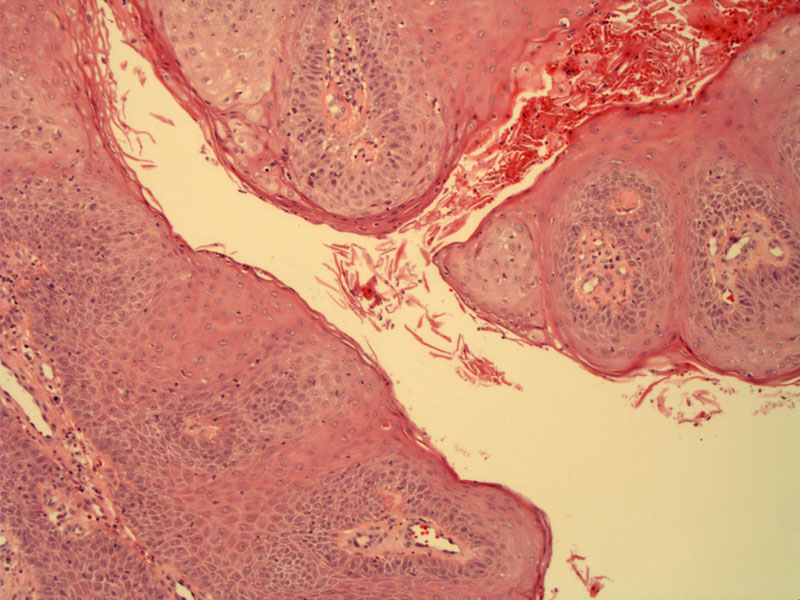

Case 1- Architectural features of condyloma acuminatum include acanthosis (epithelial hyperplasia) and papillomatous (formation of papillae). Due to the tangential section, the papillae are hard to appreciate. Parakeratosis (result of abnormal maturation) is commonly seen.
The papillae are lined by squamous epithelium demonstrating koilocytic atypia confined to the upper third of the epithelium. Koilocytia atypia (nuclear enlargement, hyperchromasia, binucleation and irregular raisinoid contours) is more prominent in the upper left corner.
Case 2 demonstrates similar features, with papillary cores lined by parakeratotic squamous epithelium in a compact architecture.
The dysplasia is evident in the parakeratotic mound emanating from between the papillae.
The upper right illustrates an area of classic low grade dysplasia showing koilocytic atypia.
Low grade squamous intraepithelial lesions may be divided into three subgroups: 1
- Condyloma acuminatum: Also known as exophytic condyloma, this lesion is characterized by a verrucous growth with broad and blunted papillae. The squamous epithelium demonstrates acanthosis, and often, parakeratosis and hyperkeratosis. Koilocytic atypia is seen in the top third of the epithelium. These lesions are associated with low-risk HPV subtypes 6 and 11 and do not progress into high-grade lesions.
- Immature condyloma: Also known as squamous papilloma or papillary immature metaplasia, these lesions have slender papillae and lined by immature squamous epithelium with mild koilocytic atypia. Similar to condyloma accuminatum, these lesions are associated with HPV-subtypes 6 and 11.
- Flat condyloma (CIN I): These lesions do not have an exophytic pattern of growth, and are associated with higher risk HPV subtypes with the potential to progress to HGSIL.
Condylomata acuminata, commonly referred to by clinicians as anogenital warts, can occur in cervix, anus, vulva and vagina. Can present with itching, burning, bleeding and vaginal discharge. Lesions are velvety in texture and can range from small and asymptomatic to large obstructive growths that can interfere with intercourse and vaginal delivery. Application of acetic acid causes the lesion to turn white for better visualization.
Various treatment modalities are available. Applying chemicals is preferred for smaller lesions. Tricholoroacetic acid is considered a good initial approach, however, repeated applications are often necessary. Podophyllin is also a good topic medicine, however, it cannot be applied on mucosal surfaces such as the vagina and is also contraindicated in pregnancy. Cryotherapy with liquid nitrogen is another commonly employed treatment modality.
For larger lesions or in situations when medical therapy is not effective, surgical removal with laser ablation or excision may be necessary.
Condyloma acuminatum is associated with low-risk HPV subtypes 6 and 11. All treatment modalities have high recurrence risks. Conditions such as AIDS and pregnancy are associated with rapid progression of lesions. It is also important to note that while benign HPV subtypes cause condyloma accuminatum, they are often present in association with the high risk HPV subtypes that may cause cancer.
1 Fletcher CDM, ed. Diagnostic Histopathology of Tumors. 3rd Ed. Philadelphia, PA: Elsevier; 2007: 697-8.
2 Nucci MR, Oliva Esther. Gynecologic Pathology: Foundations in Diagnostic Pathology. Philadelphia, PA: Elsevier: 2009: 144-5.